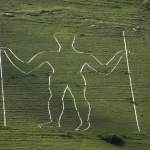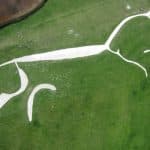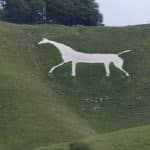Last Updated on 18/04/2023 by Alex Hamlyn
Table of Contents
Where is the Cerne Abbas Giant?
Introduction
The Cerne Abbas Giant, also known as the Rude Man, is an ancient figure carved into the chalk hills near the village of Cerne Abbas in Dorset, England. It is one of the largest and most distinctive hill figures in the UK.
The enigmatic Cerne Abbas Giant has long been a source of fascination for both locals and visitors to the verdant countryside of Dorset, England. Steeped in mystery, this colossal chalk figure has inspired a myriad of theories and interpretations.
This striking and enigmatic figure, stretches 180 feet (55 meters) in height and 167 feet (51 meters) in width, wielding a large club in its right hand. This ancient geoglyph is visible for miles around, thanks to the contrast between the bright chalk used to create the figure and the lush green grass that surrounds it.
The figure’s prominent phallus and overall imposing stature have led to various theories about its purpose and significance in the ancient world.
On a clear day, the giant can be seen from several miles away. The contrast between the white chalk of the figure and the surrounding green grass makes it stand out, allowing it to be visible from a distance. The best views are typically from elevated positions, as its position, carved into a hillside, and its full proportions can be better appreciated when viewed from above or at an angle.
Location and Age of the Cerne Abbas Giant
Although the exact age of the Cerne Abbas Giant is still debated, some experts suggest that it may have been created during the Iron Age (1200 BC – 1 AD), the Roman period (43 AD – 410 AD), or even the Medieval period (5th to 15th century AD). Radiocarbon dating of soil samples and snail shells from the site has produced inconsistent results, and the lack of historical documentation before the 17th century further complicates efforts to pinpoint its origins. Some dating estimates the figure’s age at around 700 years old, placing its creation in the late 13th or early 14th century. Other theories suggest it could be even older, perhaps dating back to the Iron Age or even the Roman period.
In terms of cultural and religious significance, the Cerne Abbas Giant has been associated with a variety of theories:
- Fertility symbol: The most popular theory is that the Cerne Abbas Giant represents a fertility symbol, due to its prominent phallus. It has been suggested that the figure may have been associated with rituals to promote fertility and agricultural prosperity. Some local legends even claim that childless couples who sleep on the figure will conceive soon after.
- Pagan god: Another theory posits that the giant represents a pagan god or deity. Some researchers have suggested that it could be an image of the ancient Celtic god Cernunnos, associated with fertility, nature, and the underworld. Others have proposed that it could depict Hercules, the Roman adaptation of the Greek hero Heracles, who was often associated with strength and virility.
- Political satire: Some historians believe that the Cerne Abbas Giant may have been created as a political satire or parody during the English Civil War (1642-1651) or the Restoration (1660-1688). In this interpretation, the figure could be a caricature of a political figure or a symbol of rebellion against religious or political authorities.
- Astronomical marker: Another possibility is that the Cerne Abbas Giant served as an astronomical marker or observatory, aligned with specific celestial events, such as solstices or equinoxes. This theory is supported by the fact that many ancient cultures placed great importance on astronomical phenomena and often constructed monuments or artwork in relation to the movement of celestial bodies.
Despite these various theories, the true purpose and origins of the Cerne Abbas Giant remain enigmatic. Its existence serves as a testament to the rich and complex history of human culture and the enduring desire to understand the motives and beliefs of our ancestors. The Cerne Abbas Giant continues to capture the imagination of researchers, historians, and visitors alike, reminding us of the countless mysteries that still await discovery in the story of humanity.
Cultural and Religious Significance
The Cerne Abbas Giant’s cultural and religious significance remains a subject of debate among scholars and the exact religious and cultural practices relating to this and similar sites are difficult to ascertain.
Nevertheless, there are certain historical and archaeological findings that provide insight into the broader context of the societies that may have created these hill figures.
Some theories suggest that the figure represents a pagan deity, such as the Celtic god Cernunnos or the Roman Hercules. Others propose that it might have been an emblem of political satire or even a fertility symbol.
The Cerne Abbas Giant’s connection to other ancient sites
While the Cerne Abbas Giant is unique in its scale and detail, it is not the only ancient chalk figure in the UK.
While there is still some debate about the exact origins and purpose of the Cerne Abbas Giant, it has some connections with other ancient sites in the UK and around the world. Here are a few examples:
- Uffington White Horse: Located in Oxfordshire, England, the Uffington White Horse is another famous hill figure. Both the Cerne Abbas Giant and the Uffington White Horse were constructed using a similar technique of carving trenches and filling them with white chalk, making them highly visible from a distance. While the Uffington White Horse is thought to be much older (dating back to the late Bronze Age or early Iron Age), the exact age of the Cerne Abbas Giant is still debated. Both sites may have been significant landmarks or held spiritual significance for their creators.
- Long Man of Wilmington: Located in East Sussex, England, the Long Man of Wilmington is another hill figure with similarities to the Cerne Abbas Giant. Both are large human representations, although the Long Man is more abstract and geometric in design. It has been suggested that both figures could have been associated with fertility rituals or sun worship, though the evidence is still inconclusive.
- Stonehenge and Avebury: These two ancient sites, located in Wiltshire, England, are renowned for their impressive stone circles. Though not directly related to the Cerne Abbas Giant in terms of construction, they provide context for understanding the broader Neolithic and Bronze Age cultures in Britain. These cultures are known for their complex religious beliefs, which often revolved around astronomy, fertility, and the cycle of life and death. It is possible that the Cerne Abbas Giant could have been part of similar religious practices, although its specific role remains uncertain.
(Aside)
- Nazca Lines: Located in the Nazca Desert in southern Peru, the Nazca Lines are a series of enormous geoglyphs created by removing the reddish-brown iron oxide-coated pebbles to reveal the light-colored earth underneath. While the Cerne Abbas Giant and the Nazca Lines are geographically and culturally distinct, both sites feature large-scale artworks visible from high vantage points, and both have intrigued researchers for years. The Nazca Lines are believed to have had religious or astronomical significance, which may hint at similar purposes for the Cerne Abbas Giant.
Construction Techniques
The construction technique used to create the Cerne Abbas Giant is indeed impressive, especially considering the primitive tools and technology available to the creators at the time. The method employed for creating this hill figure is known as “turf cutting” or “chalk carving.”
To create the Cerne Abbas Giant, the ancient builders would have carefully marked out the design of the figure on the hillside, likely using wooden stakes and ropes as measuring tools. Next, they would remove the top layer of turf and soil along the outlines of the design, creating trenches that exposed the underlying chalk bedrock. These trenches were then filled with white chalk rubble or chalk slurry to create a stark contrast against the surrounding vegetation, making the figure highly visible from a distance.
This labor-intensive process would have required a significant amount of planning, coordination, and manpower, reflecting the dedication and skill of the ancient builders. Additionally, the figure’s size and precision suggest a deep understanding of the terrain and the ability to maintain proportionality and symmetry over a large scale, which is truly remarkable.
Similar construction techniques have been identified in other ancient hill figures in the UK, such as the Uffington White Horse and the Long Man of Wilmington. These examples indicate a shared cultural practice of creating large-scale geoglyphs across different regions and time periods in ancient Britain. The Uffington White Horse, for instance, dates back to the late Bronze Age or early Iron Age, making it one of the earliest known examples of this construction method.
While it is difficult to trace the exact development of this technique over time due to the scarcity of preserved hill figures, it is evident that the practice evolved and persisted over many centuries. Later examples of hill figures, like the Cerne Abbas Giant and the Long Man of Wilmington, suggest that the basic principles of turf cutting and chalk filling remained consistent, while the artistic style and subject matter may have changed to reflect the cultural, religious, or political context of the time.
Maintenance
Over the centuries, the Cerne Abbas Giant has required regular maintenance to keep it visible and vibrant. This labour-intensive task has typically fallen to local volunteers, who have dedicated their time and effort to preserving this enigmatic piece of history.
In more recent years, the National Trust has taken over the responsibility of maintaining the Giant, enlisting the help of specialists and volunteers alike.



